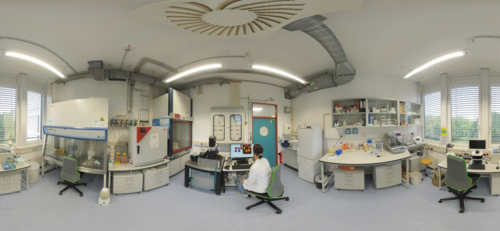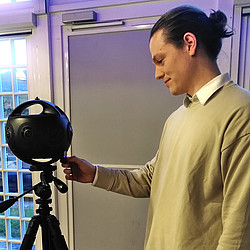Fallstudie C1
Case Study C1: Safe Materials Communication
Based on the research alliance’s topics, new innovative science communication formats will be developed and subsequently analysed. In an iterative process with all partners, content areas from basic research to technological applications, hazard assessment, and environmental impact will be identified for outreach measures. This results in virtual 3D video clips that will be used in different contexts of science communication. Our main focus is on public events, digital knowledge portals, museum exhibitions and student labs for school and extracurricular activities.



Cooperation of the partners
Based on the topics of the research network, new and innovative formats of science communication for different outreach and learning environments are jointly developed and analysed by IWM, DM and IPN. The focus is on the prerequisites of the audience as well as the investigation of effects in terms of emotional appeal, beliefs and conceptual understanding as well as hazard/risk assessment.
The doctoral project is supervised by IWM. Research stays at the IPN and DM are planned to enable a comprehensive qualification of the PhD students. In addition, the nature of the project demands visits of the partner institutes that host the other PhD students to record their work.
Leibniz-Institut für Wissensmedien (IWM)
In this cooperation, IWM will focus on the investigation of innovative digital formats for science communication (e.g. immersive 360-degree videos, web offerings for dealing with scientific contradictions) that can be used in various formal and informal contexts such as teaching, student labs or exhibitions.
Deutsches Museum (DM)
The Deutsches Museum is developing an outreach toolkit that provides scientists with simple ways to communicate their research effectively to different target groups of the public. The toolkit is complemented by a workshop lasting several days, in which the young scientists of the research network intensively deal with the theory and practice of science communication.
IPN Leibniz Institute for Science and Mathematics Education
IPN will focus on combined experimental and multimedia learning environments for young people in semi-formal educational contexts as well as the associated advanced training of teachers and science communicators. This work is linked to other ongoing research projects.
References and previous work
- Kampschulte L, Nanotechnologie im Alltag. In S. Thalhammer & M. Funke (Eds.), Nanotechnologie in der Schule: Von der Forschung in die Schule. Initiative Junge Forscherinnen und Forscher e.V., Würzburg (2017) 191. ISBN 978-3-00-058613-2
- Tirre F, Kampschulte L, Thoma G-B, Höffler T, Parchmann I, Design of a Student Lab Program for Nanoscience and Technology – an Intervention Study on Students’ Perceptions of the Nature ofScience, the Nature of Scientists and the Nature of Scientific Inquiry. Research in Science & Technological Education 37 (2019) 393. https://doi.org/10.1080/02635143.2018.1551201
- Laherto A, Kampschulte L, de Vocht M, Blonder R, Akaygun S, Apotheker J, Contextualizing the EU’s „Responsible Research and Innovation“ policy in science education: a conceptual comparison with the Nature of Science concept and practical examples. EURASIA Journal of Mathematics, Science and Technology Education 14 (2018) 2287. https://doi.org/10.29333/ejmste/89513
- Kampschulte L, Akaygün S, Adadan E, Eilert K, Heyduck B, Interdisciplinary Research Brought to School – Connecting Chemistry and Biology through Nanotechnology. J. Microbiol. Biol. Educ. 19 (2018) 19.1.4. https://doi.org/10.1128/jmbe.v19i1.1400
- Kampschulte L, Lernorte mit Medien vernetzen!? Chancen und Herausforderungen der lernortübergreifenden Mediennutzung. In: Ropohl M, Lindmeier A, Härtig H, Kampschulte L, Mühling A, Schwanewedel J, Medieneinsatz im mathematisch-naturwissenschaftlichen Unterricht – Fachübergreifende Perspektiven auf zentrale Fragestellungen. Verlag der Joachim Herz Stiftung, Hamburg (2018) 138. ISBN 978-3-945641-03-3
- Gottschling S, Kammerer Y, Gerjets P, Readers’ Processing and Use of Source Information as a Function of Its Usefulness to Explain Conflicting Scientific Claims. Discourse Processes 56:5-6 (2019) 429. https://doi.org/10.1080/0163853X.2019.1610305
- Gerjets P, Scheiter K, Digitale Medien in Unterrichtskontexten. In O Köller, M Hasselhorn, FW Hesse, K Maaz, J Schrader, H Solga, CK Spieß, & K Zimmer (Eds.), Das Bildungswesen in Deutschland. Bestand und Potenziale. Bad Heilbrunn: Klinkhardt (2019) 865. ISBN: 9783825247850
- Lang F, Kammerer Y, Oschatz K, Stürmer K, Gerjets P, The role of beliefs regarding the uncertainty of knowledge and mental effort as indicated by pupil dilation in evaluating scientific controversies. International Journal of Science Education 42:3 (2020) 350. https://doi.org/10.1080/09500693.2019.1710875
- Kammerer Y, Amann DG, Gerjets P, When adults without university education search the Internet for health information: The roles of Internet-specific epistemic beliefs and a source evaluation intervention. Computers in Human Behavior 48 (2015) 297. https://doi.org/10.1016/j.chb.2015.01.045
- Keck D, Kammerer Y, Starauschek E, Reading science texts online: Does source information influence the identification of contradictions within texts? Computers & Education 82 (2015) 442. https://doi.org/10.1016/j.compedu.2014.12.005
- Neumann I, Sorge S, Neumann K, Parchmann I, Schwanewedel J, Die Kieler Forschungswerkstatt – ein Lehr-Lern-Labor mit Fokus auf aktuelle Forschungsthemen. in B. Priemer, & J. Roth (Hrsg.), Lehr- Lern-Labore: Konzepte und deren Wirksamkeit in der MINT-Lehrpersonenbildung (S. 85-97). Berlin: Springer Spektrum (2020).
- Reimann M, Herzog S, Parchmann I, Schwarzer S, Nanotechnologie in Schülerlabor und Schule: Experimenteller Zugang zu alltagsnahen nanotechnologischen Facetten. Chemie konkret: CHEMKON; Forum für Unterricht und Didaktik 27 (2019) 215. https://doi.org/10.1002/ckon.201900038
- Laherto A, Tirre F, Parchmann I, Kampschulte L, Schwarzer S, Scientists‘ perceptions on the nature of nanoscience and its public communication. Problems of Education in the 21st Century, 76:1 (2018) 43-57.
- Kruse K, Knickmeier K, Kiessling T, Brennecke D, Bratz H, Schöps K, Parchmann I et al., Plastikmüll im Ozean: Eine Untersuchung im Fachraum und Freiland. Naturwissenschaften im Unterricht – Chemie, 29:165 (2018) 23.
- Parchmann I, Schwarzer S, Wilke T, Tausch M, Waitz T, Von Innovationen der Chemie zu innovativen Lernanlässen für den Chemieunterricht und darüber hinaus: Wie finden chemische Forschung und Entwicklung systematisch und zeitnah Eingang in unterrichtliche und außerunterrichtliche Lernprozesse? Chemie konkret: CHEMKON, 24:4 (2017) 161. https://doi.org/10.1002/ckon.201790001
Involved partners



